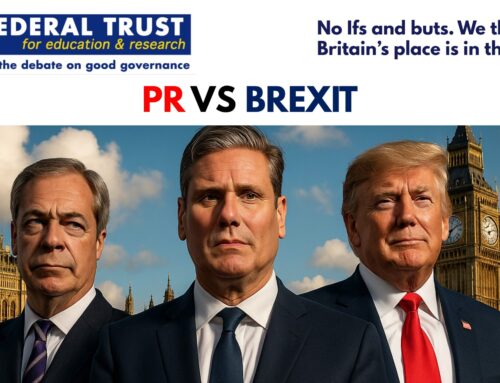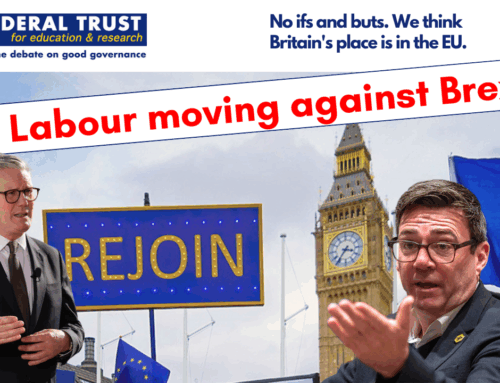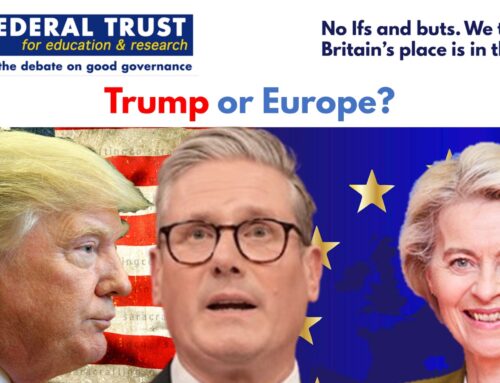A Royal Norwegian Air Force F-35 Lightning II takes off from Keflavík Airport in Iceland as part of NATO’s Air policing mission. Photo copyright: NATO

by Dr Andrew Black
Senior Research Fellow at Global Policy Institute; Senior Research Fellow, Brunel Business School
27th May 2020
How horrible, fantastic, incredible it is that we should be digging trenches and trying on gas-masks here because of a quarrel in a far away country between people of whom we know nothing.” —Neville Chamberlain, British Prime Minister
Broadcast before leaving on September 27, 1938 for a meeting with Hitler, Daladier of France and Mussolini of Italy
Introduction
Following the 2016 referendum that gave a slim majority to the Brexiteers, the European Union planted its flag in an area long resisted by Britain, that of defence. The EU would now add to its responsibilities a duty to protect EU citizens, and to protect the EU. And following on from that, and building on earlier initiatives, a series of new acronyms emerged.
The EDA (European Defence Agency) had been around since 2005 without, in the eyes of the British, having achieved very much. Then there was CARD (or the Coordinated Annual Review on Defence), which would look in detail at the state of member state defence capabilities and inform them, in case they didn’t already know, that there were deficiencies in various areas. This would be backed by PESCO (Permanent Structured Cooperation), involving more collaborative work around implementing existing defence capability programmes and in developing new ones. Much of which might then be financed through the EDF (European Defence Fund), that would over the lifetime of the next EU budget pump some € 13 billion into additional defence investment – assuming that the current budget negotiations were concluded at the upper end of budget expectations. And this was all designed to contribute to EDIDP (European Defence Industrial Development Programme), something the British government, if not the British defence industry, was not keen on supporting.
Initially, there was nothing too dramatic about these administrative steps. Yet, they provided a legal framework for EU member states to work together on some of the practical issues that NATO, for instance, often found difficult to negotiate. The EU could posit a more collective, and some would argue federal approach, whereas NATO could only provide a framework for a defensive alliance of sovereign states, whose common aims were expressed in the NATO charter, and is limited to defence matters only.
NATO’s preparedness
For many years before 2016, the British had traditionally argued that the key to European defence lay with NATO, arguably the most successful military alliance ever, but which already in 2016 was showing signs of internal strains. These strains may well be such as to jeopardise its future central role in British military planning. Pulled together under American leadership in 1949, its main role was to provide united, collaborative mutual self defence (Article 5), where an attack on one was considered to be an attack on all. The strategy worked in that a “hot” war was avoided, to be replaced by a “Cold” War. Large numbers of military personnel faced off across the Iron Curtain, thus sealing the division between a Capitalist Western Europe, and a Communist Eastern Europe.
Increasingly, and as one of the most willing US partners, Britain became an interlocutor between the US leader and the other European members, who while in the club were generally minded to follow US leadership only when it suited them. Perhaps the pinnacle of the Cold War NATO achievements was operation Desert Storm, led by the US in 1991 to liberate Kuwait from Iraq. This campaign was strongly politically supported by NATO members, and through crucial NATO logistical support. A combined force of 750 thousand military personnel were assembled, 70% from the US, 10% from NATO Europe, and the rest from allies in the Middle East and elsewhere. The British had the second largest national contingent after the US.
Yet, in this first “out of theatre” engagement, NATO military command was absent. NATO’s role was simply to release and reassign forces designated for NATO purposes to be redeployed in the first Gulf War campaign, and to provide logistical support.
Although a substantial political and military success, after the First Gulf War NATO forces began to decline. The success in rallying allies in the first Gulf War was not repeated in the second (2003). Disunity within NATO paralysed it into inaction, leaving the US to continue with a “coalitions of the willing”, rather than with wholehearted NATO support.
The “peace dividend” following the end of the Cold War, combined with the absence of another credible external threat, led to a situation where European member states cut back their military spending, reducing military capabilities further. This appeared to many to be a reasonable pay back for the years of high military spending during the Cold War.
While the amounts per member states spent on defence were declining as a proportion of GDP, so the task facing NATO in the new century became more complicated. Many Eastern European countries, now freed from supporting the Soviet Union, joined NATO. NATO’s centre of gravity moved eastwards. At a time when there was talk of getting greater Russian involvement in NATO, this did not present a problem. However, what was happening was a progressive dilution of conventional military forces, combined with an increasing complexity of organizing NATO itself.
One result of this was a growing disparity between the competence and capabilities shown by US military forces, compared with the capabilities of their European allies. Post the Great Financial Crisis in 2008/9, years of austerity further eroded Europe’s defence capabilities, with overall spending falling in many cases to below 1% of GDP. The numbers of military and civilian personnel were also being steadily reduced, by 2% a year between 2011 and 2017, a decline that accelerated after the events in the Ukraine in 2014.
The impression of NATO as commanding large and effective forces was replaced by the image of NATO becoming increasingly ossified, unable to agree on long term goals, and the indifference shown by many member states to this state of affairs. President Macron of France vented his frustration by declaring that NATO was “brain dead”.
The Americans took an increasingly dim view, and made ever more urgent efforts to bring member state defence spending up to an agreed 2% of GDP. In this they were only partially successful.
Following the annexation of the Crimea by Russia in 2014, and the subsequent civil war in the Ukraine, where a Russian speaking minority in the Donbass region established an autonomous republic independent from the rest of the Ukraine, NATO responses were far from united. Countries like the US, Germany, France and Britain did send forces to the “Eastern flank”, stationing them in Estonia, Latvia, Lithuania and Poland. These host countries also bolstered and improved their own, limited, defence capabilities. Some member states barely changed the levels of defence spending, and others continued to reduce spending including the UK. Progress in responding to peer on peer conflict was limited. While yet others, such as France, devoted energies to an entirely different type of operation, namely counter insurgency operations in Mali and in the Sahel (operation Serval), similar in nature to the International Security Assistance Force (ISAF), sponsored by NATO, that contributed to the Afghanistan campaign (2001 to 2014). But true to NATO’s indecisiveness, Operation Serval never received official backing from NATO, largely because of continuing disagreement about how to deal with “out of theatre” operations.
Difficulties in achieving consensus over NATO’s future defence posture were further amplified by open doubts expressed by the US president about whether the US felt bound by its article 5 commitments to Europe at all. Efforts by US officials to downplay such thinking were over-ridden by further statements by President Trump that he was indeed serious about making Article 5 commitments conditional on the European allies doing more. And he expressed open disbelief that America would join in an Article 5 action in defence of NATO’s latest member, Montenegro.
All of which has created serious problems for Britain’s role in NATO. At a stroke one of the main advantages of being America’s closest ally disappeared. If the US could not be relied upon, why listen to British advice that tried to bridge the Atlantic divide within the alliance? Clearly people were not listening on either side of the Atlantic, and the UK mission was failing.
Even before 2016, there were two somewhat contradictory trends occurring in European defence. The official NATO defence posture, supported by the UK, was weakening and losing support among other member states, including the most important, the USA. On the other hand, the EU and its various institutions were trying to integrate EU defence and provide their military activities with a greater sense of purpose, albeit on the basis of very small resources. So much so that it became evident that a better way of proceeding, in order to avoid the charge of duplication, would be for the EU’s defence policy to converge with NATO, and to complement some NATO policies.
At the moment there are effectively two systems of defence planning in Europe. The larger and more experienced one is the NATO defence planning process. The EU has started its own defence planning process, which only includes EU member states. Thus from the outset EU defence planning excludes the US, Canada and Turkey. The two systems converge in that most EU member states are also part of NATO, and this makes it possible to work on the common elements in defence planning that affect both the EU and NATO. As the European Parliament has suggested, the sum total of CARD, PESCO and EDF funding could be to produce what is described as defence planning “White Book” that outlines defence capabilities for the EU. This will, to a great extent, exist in parallel to NATO Defence planning processes. It needs to be borne in mind that the ulterior motive behind EU defence planning is to support EDIDP (European Defence Industrial Development Programme), which is not the same as supporting all NATO member states.
A possible (hypothetical) future
It is entirely possible that in the medium term growing US isolationism and impatience with the further dilapidation of NATO Europe, may persuade the US that there is little more to be gained by staying in NATO. The US has other strategic concerns, particularly involving China, as well as developments in Africa and South America, so the US effectively leaves NATO. This could be through a sense of increasing semi-detachment, as the UK practiced with the EU under Cameron, or through a more formal withdrawal. NATO is further weakened by the effective loss of Turkey as an ally, as Turkey too decides to follow its own strategic interests in the Middle East and Central Asia, away from Europe.
Then assume that the EU continues on its expansion path, as a further means towards strengthening European integration. At the political and legal level the Union makes expansive promises, promises that exceed the resources it has to implement them. Taking military advice, the EU’s High Representative, backed by some key member states, decides to boldly support a bid of a country in Eastern Europe to join the EU, a country which the Russian Federation regards as being within its traditional orbit of influence. At which point, as happened in the Ukraine, Russian military forces invade and occupy the country in question.
The Response and the Retreat
Panic stations in Brussels and in member state capitals; emergency meetings of the European Council and the European Parliament. The NATO council is summoned, and cannot agree on what to do. NATO is largely absent militarily. Confusion as to who is responsible. Should the initiative rest with Romania, whose interests are most threatened, and whose military forces are still largely made up of ex-Soviet equipment? What about Hungary? What do the European “Great Powers” think about it?
The Europeans cannot agree either. The occupied country is not formally part of the EU, although a candidate to do so. NATO is unprepared in that region. Rapid response forces are either still in training, or are committed elsewhere. And there is a threat that concerted action by the “West” will spark off a major conventional war with Russia. Is there sufficient agreement to come to a consensus? And where will Britain stand in such a scenario? Britain’s military ambitions are thwarted by NATO’s continuing ossification, as well as being weakened by on-going domestic austerity. Britain’s military ambitions are further weakened by being excluded from EU defence initiatives as a result of Brexit. Britain is faced with few palatable choices. With their main American ally now back at home across the Atlantic, the likely British response could well be to just “wash your hands” of a “far away country where there are quarrels between people of whom we know nothing”. With little interest in contributing to an EU army, or to supporting EDIDP, Britain could take the opportunity to renege entirely on its international commitments (something it appears to be doing with alacrity over Brexit). And to show it means business, resign from NATO on the grounds that it is no longer fit for purpose. It would be an ironic outcome if Brexit led in the medium term not merely to British withdrawal from the EU, but also from NATO as well.





